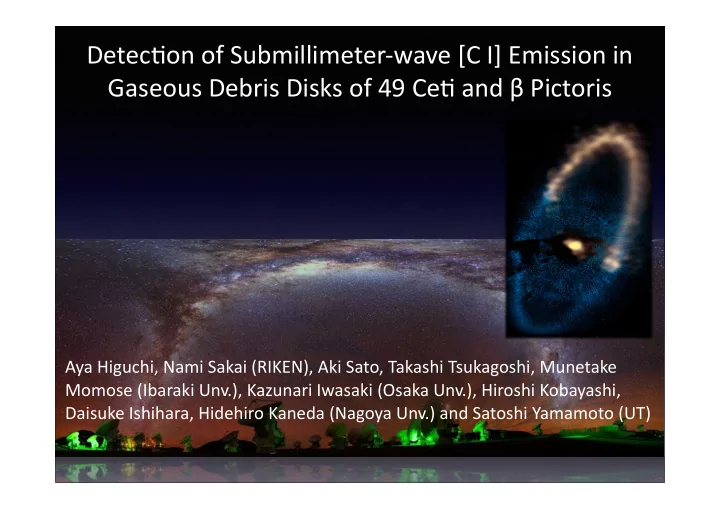

Detec%on of Submillimeter-wave [C I] Emission in Gaseous Debris Disks of 49 Ce% and β Pictoris Aya Higuchi, Nami Sakai (RIKEN), Aki Sato, Takashi Tsukagoshi, Munetake Momose (Ibaraki Unv.), Kazunari Iwasaki (Osaka Unv.), Hiroshi Kobayashi, Daisuke Ishihara, Hidehiro Kaneda (Nagoya Unv.) and Satoshi Yamamoto (UT)
ALMA/NAOJ Evolu%onary stages from protoplanetary disk to debris disk ?
Protopranetary Disk Debris Disk > 10 M ⊕ < 1M ⊕ dust L disk /L * > 0.01 L disk /L * < 0.01 op%cally thick op%cally thin affected by radia%on dust condi%on protected by gas presssure primordial gas condi%on primordial or secondary gas/dust mass ra%o ~100 disk structure thick thin age < 10 Myr 10Myr - 10Gyr
CO gas survey • Previous CO survey • Zuckerman et al. (1995, IRAM), Dent et al. (2005, JCMT), Hales et al. (2014, APEX+ASTE), Moor et al. (2011, 2015, APEX+IRAM). • 3/70 objects - CO detec%on • 49Ce% (Zuckerman et al. 1995, Dent et al. 2005) • HD 21997 (Moor et al. 2011) • HD131835 (Moor et al. 2015) JCMT CO(3-2) JCMT Dent et al. (2005)
CO gas survey • ALMA observa%ons • Scorpius-Centaurus associa%on (Lieman-Sifry et al. 2016) - 23 objects • CO detec%ons: newly HIP 76310, and HIP 84881 + confirma%on of HD 131835. • 12 CO+ 13 CO detec%on: HD121191, HD121617, and HD131488 (Moor et al. con%nuum 2017) • Individual objects • CO detec%on : β Pic (Dent et al. 2014), Fomalhaut (Matra et al. 2017) CO(2-1) (Dent et al. 2014) 100 au
Origin of gas • Primordial • Remnant gas of protoplanetary disks (e.g., Kospal et al. 2013). • Gas composi%on: ISM abundance (e.g., X(CO) = 10 -4 ) as in protoplanetary disks • Secondary • Sublima%on of dust grains (e.g., Kobayashi et al. 2008) or planetesimals (Lagrange et al. 1998), collision of comets or icy planetesimals (Zuckerman & Song 2012). • Gas composi%on • CO : main gas, only a small amount of H 2 is expected. • CO : photodissocia%on —> C, C+
Observa%ons Atacama Submillimeter Telescope Experiment (ASTE) (Sep. - Oct. 2016) •[C I]: 492.161 GHz (Band 8 receiver) •dv=1.1km/s •rms=25mK (in T A ) •Integra%on %me(on source) > 15h •CO(3-2): 345.796 GHz •dv=0.76km/s •rms=6mK (in T A ) Hughes et al. 2017 ALMA CO(3-2) images
49 Ce% β Pictoris Higuchi et al. 2017 Intensity [K] ~100 hours V LSR [km/s]
Intensity [K] High C/CO column density ra%o !!: 54±19(49 Ce%) ; 69±42(β Pictoris) —> These ra%os are higher than those of molecular clouds and diffuse clouds by an order of magnitude (e.g., Mt. Fuji telescope). V LSR [km/s]
Chemical reac%on of CO If there is a large amount of H 2 molecular gas, C will easily return to CO. H 2 reac1on O reac1on Photodissocia1on (photodissocia1on) e reac1on Higuchi et al. 2017 Chemical reac%on of CO in the interstellar medium. CO is dissociated by ultraviolet radia%on to become C and C + . If there are large amount of H 2 , C + will return to CO again.
Chemical reac%on of CO The high C/CO ra%os are likely awributed to a lack of H 2 molecule ? H 2 reac1on O reac1on Photodissocia1on (photodissocia1on) e reac1on Higuchi et al. 2017 Chemical reac%on of CO in the interstellar medium. CO is dissociated by ultraviolet radia%on to become C and C + . If there are large amount of H 2 , C + will return to CO again.
Origin of gas • Primordial • Remnant gas of protoplanetary disks (e.g., Kospal et al. 2013). • Gas composi%on: ISM abundance (e.g., X(CO) = 10 -4 ) as in protoplanetary disks • Secondary • Sublima%on of dust grains (e.g., Kobayashi et al. 2008) or planetesimals (Lagrange et al. 1998), collision of comets or icy planetesimals (Zuckerman & Song 2012). • Gas composi%on • CO : main gas, only a small amount of H 2 is expected. • CO : photodissocia%on —> C, C+
Summary • We have firstly detected [C I] emissions in the gaseous debris disks of 49 Ce% and β Pictoris with the ASTE. • The line profiles of [C I] are found to resemble those of CO(J=3–2). • This result suggests that atomic carbon (C) coexists with CO in the debris disks and is likely formed by the photodissocia%on of CO. • The C/CO column density ra%o is thus derived to be 54 ± 19 and 69 ± 42 for 49 Ce% and β Pictoris, respec%vely. • The high C/CO ra%os are likely awributed to a lack of H 2 molecules. • This result implies a small number of H 2 molecules in the gas disk, i.e., there is an appreciable contribu%on of secondary gas from dust grains.
Future work • (Higuchi) ALMA observa%on with the high resolu%on and sensi%vity to understand the spa%al and velocity distribu%on of [C I] emission. Understanding the spa%al distribu%on of [C I] emission with ALMA • Deriva%on of C/CO and Gas to Dust (G/D) ra%o • • (Sato) ASTE observa%on for increasing the number of [C I] detec%on sources. • (Quen%n Kral/Mark Wyaw/Luca Matra) Collabora%on with UK team for following up APEX result. • (Iwasaki/Kobayashi) Modeling of the photodissocia%on and chemical reac%ons in debris disks (PDR calcula%on) for giving a constraint on the amount of hydrogen molecule in debris disks
Recommend
More recommend